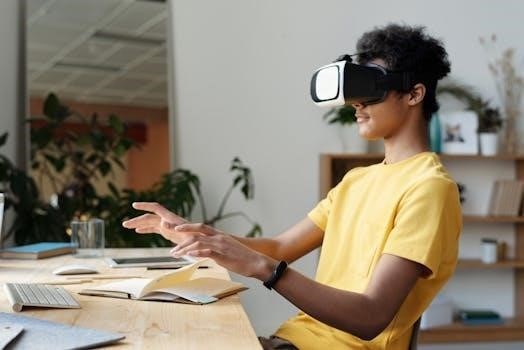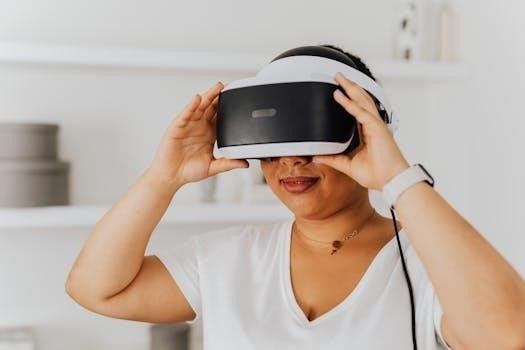
Sonos Play⁚1 User Guide
The Sonos Play⁚1 is a versatile wireless speaker designed for seamless audio experiences. This guide provides comprehensive instructions on setup, usage, and maintenance. It covers everything from initial network connection to advanced features like stereo pairing and surround sound setup, ensuring you get the most out of your Play⁚1.
Initial Setup and Network Connection

To begin using your Sonos Play⁚1, the initial setup and network connection are crucial steps. First, place your Play⁚1 in your desired location, keeping in mind that it performs well even near walls or on shelves, but for optimal performance, allow at least one inch of space. Next, connect the power cord firmly to the bottom of the Play⁚1 until it is flush with the unit. Now, you have two options for connecting your Play⁚1 to your home network⁚ via an Ethernet cable or wirelessly. If choosing the Ethernet option, simply connect one end of the cable to the Play⁚1 and the other to your router. For wireless setup, ensure you have a wireless router and download the Sonos app for iOS or Android devices. The Sonos app will guide you through the wireless connection process. Follow the app’s instructions to connect your Play⁚1 to your Wi-Fi network. This will involve selecting your network and entering your password. Once connected, your Play⁚1 is ready for use. Remember that at least one Sonos device must be connected to your network.
Connecting via Ethernet Cable
Connecting your Sonos Play⁚1 via an Ethernet cable offers a stable and reliable network connection, particularly useful in areas with potential wireless interference or for users who prefer a wired setup. To initiate this connection, first locate the Ethernet port on the back of your Sonos Play⁚1. Next, take one end of an Ethernet cable and firmly insert it into the Ethernet port on the Play⁚1. Then, take the other end of the same Ethernet cable and connect it to an available Ethernet port on your home network router. Ensure that the connection is secure at both ends. Once the connection is established, the Sonos Play⁚1 should automatically detect the wired network connection. The link light on both the router and the Sonos component should be lit solid, while the activity lights should be blinking, indicating data transfer. With a wired connection, your Play⁚1 will now be connected to your home network. This provides a direct path for data, ensuring consistent and uninterrupted audio playback. This wired method may also be useful for initial setup and troubleshooting.

Wireless Connection Setup
Setting up a wireless connection for your Sonos Play⁚1 allows for flexible placement without the constraints of Ethernet cables. To begin, ensure your Play⁚1 is powered on and placed within range of your wireless router. Download and open the Sonos app on your smartphone or tablet. The app will guide you through the initial setup process. Select the option to add a new Sonos device and follow the prompts. When requested, choose the wireless setup method. The app will then search for available Sonos devices on your network. Once your Play⁚1 is detected, select it from the list. You will be prompted to enter your Wi-Fi network password to connect the speaker to your wireless network. After entering the correct password, the app will configure the wireless connection to your Play⁚1. You will see a confirmation message once the process is successful. The Sonos app will confirm that your Play⁚1 is now connected wirelessly and ready for use. Remember to keep your Wi-Fi password handy during the setup process and that your device must be within Wi-Fi range.
Using the Sonos App
The Sonos app is the central hub for controlling your Sonos Play⁚1 and entire Sonos system. It allows you to manage your music sources, playback, and settings with ease. Once your Play⁚1 is connected to your network, open the Sonos app on your mobile device or computer. The app will automatically detect your Play⁚1. The main screen displays all the rooms in your Sonos system; select the room where your Play⁚1 is located to begin controlling music. Within the app, navigate through your music services, including streaming platforms, radio stations, and your local music library. Select your preferred music source, choose the Play⁚1 as the playback destination, and start playing your favorite songs. The app also provides controls for adjusting the volume, skipping tracks, pausing or resuming playback, and creating playlists. You can also search for specific songs or artists across all your music sources simultaneously. The Sonos app is designed to be user-friendly, making it easy to enjoy music throughout your home. Furthermore, you can control playback in one or all rooms simultaneously, using the app’s intuitive interface.
Playing Music on Sonos Play⁚1
After successfully setting up your Sonos Play⁚1 and connecting it to your network, you can start enjoying your favorite music. To begin, open the Sonos app on your smartphone, tablet, or computer. Within the app, navigate to the ‘Browse’ tab to access your various music sources. You can select from a variety of streaming services like Spotify, Apple Music, or Amazon Music, or choose to play music from your personal library, or listen to thousands of free internet radio stations. Once you’ve chosen your music source, simply select the desired song, album, or playlist. Then, choose the specific room where your Sonos Play⁚1 is located as the playback destination. The music will begin playing on your Play⁚1, offering crisp and clear audio. The Sonos app provides playback controls, allowing you to pause, skip tracks, adjust the volume, and create playlists. You can also group multiple rooms together to play the same music throughout your home. The Sonos Play⁚1 delivers a dynamic audio experience, bringing your favorite tunes to life with quality sound.
Controlling Playback and Volume
The Sonos Play⁚1 offers convenient ways to control playback and volume, allowing you to easily manage your listening experience. The primary method of control is through the Sonos app. Within the app, you’ll find intuitive controls to play, pause, skip tracks, and adjust the volume of your Sonos Play⁚1. The app’s interface provides a seamless way to manage music from various sources, from your favorite streaming services to your personal music library. Additionally, the Play⁚1 features physical touch controls located on the top of the speaker. These controls allow you to adjust volume by tapping the volume up and down buttons. You can also play or pause your music by tapping the play/pause button. These physical controls provide an alternative way to manage playback without needing your phone. For quick control, you can also use your voice assistant, if you have it set up with your Sonos system. The intuitive design of the Sonos app and physical controls makes it easy to manage your music quickly and easily;

Disabling Touch Controls
The Sonos Play⁚1 features touch-sensitive controls on the top of the speaker, which are used to manage playback and volume. However, there are situations where you might prefer to disable these controls, such as when you have children or pets who might accidentally activate them, or simply if you prefer to only control your system from the app. Disabling the touch controls is a straightforward process that can be done through the Sonos app. To do so, navigate to the settings menu within the app, and then select “Room Settings”. Choose the specific Sonos Play⁚1 speaker you wish to modify, and then look for a setting labeled “Touch Controls”. Here you will find the option to toggle the touch controls on or off. When disabled, the buttons on the Play⁚1 will no longer respond to touch, preventing accidental interruptions to your listening. This gives you the ability to customize the level of interaction with the speaker for greater control and peace of mind.
Optimal Speaker Placement
Proper placement of your Sonos Play⁚1 is crucial for achieving the best possible sound quality. While the Play⁚1 is designed to sound great in various locations, there are some guidelines to consider. The speaker performs well when placed near a wall or on a shelf, but for optimal performance, it’s recommended to leave at least one inch of space around it. This allows for proper airflow and prevents sound from being muffled. Avoid placing the Play⁚1 in enclosed spaces or corners, as this can cause the bass to become overwhelming. If you are using a single Play⁚1, try to place it in a central location within the room. For a stereo pair setup, position the two speakers about 8 to 10 feet apart, and your listening position should be 8 to 12 feet away from them. Less distance will increase bass, and more distance will enhance stereo imaging. It is also important to avoid direct sunlight or excessive heat, as this can damage the speaker. Experiment with different positions to find the sound that best suits your space and preferences.
Creating a Stereo Pair
Enhance your audio experience by creating a stereo pair with two Sonos Play⁚1 speakers. This setup separates the left and right audio channels, providing a wider and more immersive soundstage. To create a stereo pair, both Play⁚1 speakers must be connected to the same Sonos system. Begin by navigating to the Room Settings in the Sonos app and select the two speakers you want to pair. Choose the option to create a stereo pair. The app will guide you through the setup process, which typically involves assigning one speaker as the left channel and the other as the right channel. For optimal performance, position the two Play⁚1 speakers about 8 to 10 feet apart. Your primary listening position should ideally be 8 to 12 feet away from the paired speakers. Less distance will emphasize bass response, while greater distance will enhance stereo separation. Once paired, the speakers will act as a single audio zone, providing synchronized playback. You can manage the stereo pair as one unit within the Sonos app.
Adding Surround Speakers
Transform your home theater setup by adding two Sonos Play⁚1 speakers as surround channels. This configuration pairs the Play⁚1s with a Sonos PLAYBAR (or other compatible Sonos home theater product) to create a more immersive 5.1 surround sound experience. You can either add surround speakers during the initial setup or at a later time. To add surround speakers after initial setup, navigate to the Room Settings within the Sonos app and choose the room where your PLAYBAR is located. This room will appear as ‘Room (LSRS)’ in the menu. Next, select ‘Advanced Audio’ and then ‘Surround Settings’. The app will guide you through the pairing process, which involves assigning the two Play⁚1 speakers as the left and right surround channels. For the best performance, position the surround speakers behind or to the sides of your primary listening area, typically at ear level or slightly above. The Play⁚1s will now act as dedicated surround speakers, enhancing the spatial audio effects for movies and other content.
Troubleshooting Connection Issues
Encountering connection problems with your Sonos Play⁚1 can be frustrating, but most issues can be resolved with a few simple steps. If your Play⁚1 is not detected during setup, a network problem is likely the cause. Start by checking the link/activity lights on both your router and the Play⁚1; the link lights should be solid, and the activity lights should be blinking. If you are using a wireless connection, try moving the Play⁚1 closer to your router or temporarily connecting it via an Ethernet cable to see if the issue is due to wireless interference. If the Play⁚1 is in a fault mode, it may display a flashing amber light followed by white. Ensure that the room temperature is below 104°F/40°C and avoid direct sunlight, which could cause overheating. In cases of persistent issues, visit the Sonos website for additional troubleshooting steps or contact support.
Safety and Maintenance
To ensure the longevity and optimal performance of your Sonos Play⁚1, it’s crucial to adhere to some safety and maintenance guidelines. Avoid using the speaker near water, as it is not waterproof or water-resistant. Clean the Play⁚1 using only a dry, soft cloth; do not use household cleaners or solvents, which can damage the finish. Position your speaker away from heat sources like radiators or stoves. The Play⁚1 is designed to withstand high humidity, such as in a bathroom with a shower, but it is not intended for direct exposure to water. The device should be placed in a room temperature that is not excessively hot, avoiding direct sunlight, and ensuring adequate ventilation. If you are not using a router, you can visit the Sonos website for more information.
